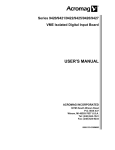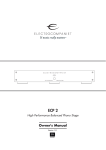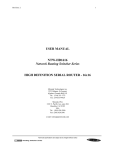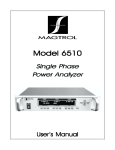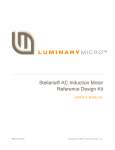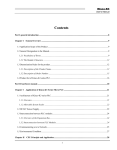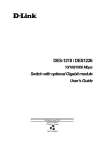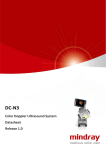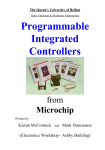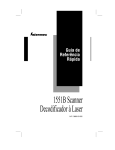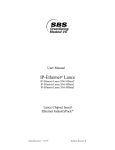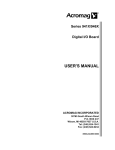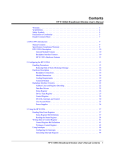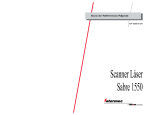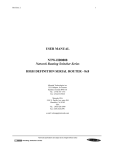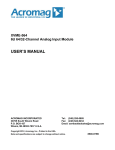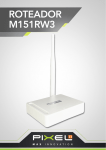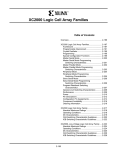Download USER`S MANUAL
Transcript
Series 9440/9443/9447
Isolated Digital I/O Board
USER’S MANUAL
ACROMAG INCORPORATED
30765 South Wixom Road
P.O. BOX 437
Wixom, MI 48393-7037 U.S.A.
Tel: (248) 624-1541
Fax: (248) 624-9234
8500-309-D01E001
AVME9440/9443/9447
ISOLATED DIGITAL I/O BOARDS
____________________________________________________________________________
The information in this manual is subject to change without notice. Acromag, Inc., makes no warranty
of any kind with regard to this material, including, but not limited to, the implied warranties of
merchantability and fitness for a particular purpose. Further, Acromag, Inc., assumes no
responsibility for any errors that may appear in this manual and makes no commitment to update, nor
keep current, the information contained in this manual.
No part of this manual may be copied or reproduced in any form, or by any means, without the prior
written consent of Acromag, Inc.
IMPORTANT SAFETY CONSIDERATIONS
It is very important for the user to consider the possible adverse effects of power, wiring, component,
sensor or software failures in designing any type of control or monitoring system. This is especially
important where economic property loss or human life is involved. It is important that the user employ
redundancy, and comprehensive failure analysis to insure a safe and satisfactory overall system
design. It is agreed between the Buyer and Acromag, that this is the Buyer's responsibility.
ACROMAG, INCORPORATED
30765 South Wixom Road
PO Box 437
Wixom, MI 48393-7037, USA
Tel: (248) 624-1541
Fax: (248) 624-9234
Copyright 1992, 1995 Acromag, Inc. Printed in USA
Data and specifications subject to change without notice
-1-
AVME9440/9443/9447
ISOLATED DIGITAL I/O BOARDS
___________________________________________________________________________
TABLE OF CONTENTS
CHAPTER
1.0
1.1
1.2
1.3
1.4
1.5
Page
GENERAL INFORMATION......................................................................................................
INTRODUCTION......................................................................................................................
DIGITAL INPUT FEATURES ( 9440-I & 9447-I )......................................................................
DIGITAL OUTPUT FEATURES ( 9440-I & 9443-I )..................................................................
VMEbus INTERFACE FEATURES...........................................................................................
FIELD COMPATIBILITY...........................................................................................................
1.5.1 Digital Inputs.....................................................................................................................
1.5.2 Digital Outputs..................................................................................................................
4
4
4
4
5
5
5
5
2.0
2.1
2.2
2.3
PREPARATION FOR USE.......................................................................................................
UNPACKING AND INSPECTION.............................................................................................
CARD CAGE CONSIDERATIONS...........................................................................................
BOARD CONFIGURATION......................................................................................................
2.3.1 Default Jumper Configuration...........................................................................................
2.3.1.1 Digital Input Default Configuration..........................................................................
2.3.1.2 Digital Output Default Configuration.......................................................................
2.4 VMEbus CONFIGURATION....................................................................................................
2.4.1 Address Decode Jumper Configuration...........................................................................
2.4.2 Address Modifier Jumper Configuration...........................................................................
2.4.3 Interrupt Level Select Jumper Configuration....................................................................
2.5 DIGITAL INPUT CONFIGURATION ( 9440-I & 9447-I ) .........................................................
2.5.1 Digital Input Threshold Detection.....................................................................................
2.5.2 Sensing Contact Closures and Switches.........................................................................
2.5.3 Debounce Delay Selection...............................................................................................
2.6 DIGITAL OUTPUT CONFIGURATION ( 9440-I & 9443-I ) .....................................................
2.6.1 Relay Coils and Other Inductive Loads............................................................................
2.7 DIGITAL INPUT/OUTPUT INTERFACE TO TTL AND CMOS SIGNALS................................
2.8 CONNECTORS........................................................................................................................
2.8.1 Digital Input Connector.....................................................................................................
2.8.2 Digital Output Connector..................................................................................................
2.8.3 VMEbus Connections.......................................................................................................
2.9 POWER-UP TIMING AND LOADING......................................................................................
2.10 DATA TRANSFER TIMING.....................................................................................................
2.11 FIELD GROUNDING CONSIDERATIONS..............................................................................
5
5
6
6
6
6
6
7
7
8
8
8
9
9
9
9
9
10
10
10
11
11
12
13
13
3.0 PROGRAMMING INFORMATION...........................................................................................
3.1 MEMORY MAP.........................................................................................................................
3.1.1 Board Identification PROM...............................................................................................
3.1.2 Board Status Register.......................................................................................................
3.1.2.1 Status Bits Usage....................................................................................................
3.1.3 Interrupt Vector Registers.................................................................................................
3.1.4 Digital Input Channel Interrupt Status Register.................................................................
3.1.5 Digital Input Channel Interrupt Enable Register................................................................
3.1.6 Digital Input Channel Interrupt Polarity Register...............................................................
3.1.7 Digital Input Channel Interrupt Type Select Register........................................................
3.1.8 Digital Input Channel Interrupt Pattern Enable Register...................................................
3.1.9 Digital Input Channel Data Register..................................................................................
3.1.10 Digital Output Channel Data Register..............................................................................
3.2 GENERAL PROGRAMMING CONSIDERATIONS..................................................................
3.2.1 Board Diagnostics.............................................................................................................
13
13
15
16
16
17
17
18
18
18
19
19
19
20
20
-2-
AVME9440/9443/9447
ISOLATED DIGITAL I/O BOARDS
____________________________________________________________________________
TABLE OF CONTENTS
CHAPTER
Page
3.3 GENERATING INTERRUPTS..................................................................................................
3.3.1 Interrupt Example For Change Of State (COS)................................................................
3.3.2 Interrupt Example For Input Level (Polarity) Match..........................................................
3.3.3 Interrupt Example For Input Pattern Match.......................................................................
3.3.4 Sequence of Events For an Interrupt................................................................................
20
21
21
22
22
4.0 THEORY OF OPERATION.......................................................................................................
4.1 VMEbus INTERFACE...............................................................................................................
4.1.1 VMEbus Control Logic......................................................................................................
4.1.2 VME Interrupter................................................................................................................
4.2 REGISTER LOCATION SUMMARY........................................................................................
4.3 ISOLATION BARRIER.............................................................................................................
4.4 DIGITAL INPUT SECTION ( 9440-I & 9447-I ).........................................................................
4.5 DIGITAL OUTPUT SECTION ( 9440-I & 9443-I ).....................................................................
23
23
23
23
24
24
24
24
5.0
5.1
5.2
5.3
SERVICE AND REPAIR INFORMATION................................................................................
SERVICE AND REPAIR ASSISTANCE...................................................................................
PRELIMINARY SERVICE PROCEDURE................................................................................
PARTS LISTS...........................................................................................................................
25
25
25
25
6.0 SPECIFICATIONS....................................................................................................................
29
FIGURES:
2.1
2.2
2.3
2.4
2.5
2.6
2.7
3.3
4.1
AVME944X JUMPER LOCATION DRAWING (4501-130).......................................................
AVME944X-I-L LED EXPANSION BOARD ASSEMBLY (4501-125).......................................
AVME944X SIMPLIFIED DIGITAL INPUT POINT SCHEMATIC (4501-131)...........................
AVME944X DIGITAL INPUT POINT CONFIGURATIONS (4501-132)....................................
AVME944X SIMPLIFIED DIGITAL OUTPUT POINT SCHEMATIC (4501-133).......................
AVME944X DIGITAL OUTPUT POINT CONFIGURATIONS (4501-134)................................
AVME944X INTERFACE TO TTL AND CMOS SIGNALS (4501-137).....................................
AVME944X INPUT RESPONSE AND INTERRUPT TIMING DIAGRAM (4501-124)..............
AVME944X BLOCK DIAGRAM (4501-128)..............................................................................
AVME944X SCHEMATIC & PART LOCATION DRAWING (4501-129)...................................
AVME944X LED EXPANSION BOARD SCH. & PART LOC. DRAWING (4501-136)..............
31
32
33
34
35
36
37
38
39
40
53
APPENDIX:
A.0 CABLE AND TERMINATION PANELS..................................................................................
A.1 CABLE: MODEL 9944-x..........................................................................................................
A.2 TERMINATION PANELS: MODELS 6985-16DI AND 6985-16DO.........................................
55
55
55
9944-X FLAT 64 PIN CABLE (4501-135)........................................................................................
6985-16DX SCHEMATIC & PART LOCATION DRAWING (4501-126)..........................................
6985-16DX MOUNTING CLEARANCE & ELECTRICAL CONNECTIONS (4501-127)..................
57
58
60
-3-
AVME9440/9443/9447
ISOLATED DIGITAL I/O BOARDS
___________________________________________________________________________
1.0 GENERAL INFORMATION
1.1 INTRODUCTION
The AVME944x Series of VME cards offer a variety of features which make them an ideal choice for many
industrial and scientific applications.
MODEL
AVME9440-I
AVME9440-I-L
AVME9443-I
AVME9443-I-L
AVME9447-I
AVME9447-I-L
16 Channel
Digital In
XX
XX
16 Channel
Digital Out
XX
XX
XX
XX
XX
XX
Channel On
LEDs
XX
XX
XX
General Features
•
•
•
•
•
All Digital Inputs and Outputs are optically isolated from the VMEbus and from each other (250 VAC).
Field connections accessible through connectors mounted on the Front Panel.
Can be interfaced to TTL & CMOS logic.
PASS/FAIL status indicator LEDs on the front panel.
Optional Termination Panels.
1.2 DIGITAL INPUT FEATURES ( 9440-I & 9447-I )
•
•
•
•
•
•
16 input points configured as a 16 bit word.
Input range of up to 55 VDC (over 2 selectable ranges).
Optically-coupled logic gates.
Adjustable debounce circuitry.
Generation of interrupts for channels 0 through 7: input Change Of State (COS), input level (polarity) match,
or input pattern detection.
Input channel ON indicating LEDs (with -L option).
1.3 DIGITAL OUTPUT FEATURES ( 9440-I & 9443-I )
•
•
•
•
•
16 output points configured as a 16 bit word.
Ability to read back output states (for complete confidence in the output setting, the output should be fed
back to an input point and the input point monitored).
Outputs sink up to 1 Amp DC, from up to a 55 VDC source.
Solid State Relays (SSRs) operate as Single Pole, Single Throw (SPST), Form A relays.
Output channel ON (output switch closed) indicating LEDs (with -L option).
-4-
AVME9440/9443/9447
ISOLATED DIGITAL I/O BOARDS
____________________________________________________________________________
1.4 VMEbus INTERFACE FEATURES
•
•
•
•
•
Slave module A24/A16, D16/D08 (EO).
Short I/O Address Modifiers 29H, 2DH (H = Hex).
Standard Address Modifiers 39H, 3DH (H = Hex).
I(1-7) interrupter, jumper programmable interrupt level, software programmable interrupt vectors (for digital
input channels 0-7), interrupt release mechanism is Release On Register Access (RORA) type.
Decode on 1K byte boundaries.
1.5 FIELD COMPATIBILITY
See APPENDIX A for more information on compatible products.
1.5.1 Digital Inputs
Directly compatible with Acromag input termination panel.
Cable:
Model 9944-X: Flat 64 pin cable (female connectors at both ends) for connecting the AVME944X to the
6985-16DI termination panel.
Termination Panel:
Model 6985-16DI: Sixteen channel input digital termination panel.
1.5.2 Digital Outputs
Directly compatible with Acromag output termination panel.
Cable:
Model 9944-X: Flat 64 pin cable (female connectors at both ends) for connecting the AVME944X to the
6985-16DO termination panel.
Termination Panel:
Model 6985-16DO: Sixteen channel output digital termination panel.
2.0 PREPARATION FOR USE
This chapter provides information about preparing the Isolated Digital I/O Board for system operation.
2.1 UNPACKING AND INSPECTION
Inspect the shipping carton immediately upon receipt for evidence of mishandling during transit. If the shipping
carton is severely damaged or water stained, request that the carrier's agent be present when the carton is
opened. If the carrier's agent is absent when the carton is opened and the contents of the carton are damaged,
keep the carton and packing material for the agent's inspection.
-5-
AVME9440/9443/9447
ISOLATED DIGITAL I/O BOARDS
___________________________________________________________________________
For repairs to a product damaged in shipment, refer to the Acromag Service Policy to obtain return instructions.
It is suggested that salvageable shipping cartons and packing material be saved for future use in the event the
product must be shipped.
The board is physically protected with foam and electrically protected with an antistatic bag during shipment. It
is advisable to visually inspect the board for evidence of mishandling prior to applying power.
CAUTION
SENSITIVE ELECTRONIC DEVICES
USE ANTI-STATIC HANDLING PROCEDURES
2.2 CARD CAGE CONSIDERATIONS
Refer to the specifications for bus loading and power requirements. Be sure that the system power supplies are
able to accommodate the additional requirements within the voltage tolerances specified.
Adequate air circulation must be provided to prevent a temperature rise above the maximum operating
temperature. Large and continuing fluctuations in ambient air temperature should be avoided. If the installation
is in an industrial environment and the board is exposed to environmental air, careful consideration should be
given to air filtering.
2.3 BOARD CONFIGURATION
The board may be configured in a variety of ways for many different applications. Each possible jumper setting
will be discussed in the following sections. The jumper locations are shown in Figure 2.1. Note that if you have
a model containing the LED Expansion Board (-L suffix), it must be removed to change the digital input channel
range jumpers (J9-J24). See Figure 2.2 for the LED Expansion Board assembly instructions.
2.3.1 Default Jumper Configuration
VMEbus INTERFACE CONFIGURATION
When a board is shipped from the factory, it is configured as follows:
•
•
•
VMEbus Short I/O Address of 0000H.
Set to respond to both Address Modifiers 29H and 2DH.
Interrupt Level: none. Therefore, even if interrupts are enabled, no interrupts will be caused.
2.3.1.1 Digital Input Default Configuration
•
•
•
16 dedicated digital input points (numbered 0 through 15).
All channels factory configured (via jumpers) for the 4-25V DC input range.
Minimum input debounce selected.
2.3.1.2 Digital Output Default Configuration
•
16 dedicated digital output points (numbered 0 through 15).
-6-
AVME9440/9443/9447
ISOLATED DIGITAL I/O BOARDS
____________________________________________________________________________
2.4 VMEbus CONFIGURATION
2.4.1 Address Decode Jumper Configuration
The board interfaces with the VMEbus as a 1K block of address locations in the VMEbus Short I/O Address
Space or Standard Address Space. J2 and J1 decode the fourteen most significant address lines A10 through
A23 to provide segments of 1K address space. The configuration of the jumpers for different base address
locations is shown below. "IN" means that the pins are shorted together with a shorting clip. "OUT" indicates
that the clip has been removed. J2 decodes address lines A10 through A15 and J1 decodes Address lines A16
through A23. Therefore, when configured for the Short I/O Address space, only J2 needs to be configured.
Pins of J2
BASE
ADDR
(HEX)
0000
0400
0800
0C00
1000
.
.
.
EC00
F000
F400
F800
FC00
A15
(11 & 12)
OUT
OUT
OUT
OUT
OUT
.
.
.
IN
IN
IN
IN
IN
A14
(10 & 9)
OUT
OUT
OUT
OUT
OUT
.
.
.
IN
IN
IN
IN
IN
A13
(8 & 7)
OUT
OUT
OUT
OUT
OUT
.
.
.
IN
IN
IN
IN
IN
A12
(6 & 5)
OUT
OUT
OUT
OUT
IN
.
.
.
OUT
IN
IN
IN
IN
A11
(4 & 3)
OUT
OUT
IN
IN
OUT
.
.
.
IN
OUT
OUT
IN
IN
A10
(2 & 1)
OUT
IN
OUT
IN
OUT
.
.
.
IN
OUT
IN
OUT
IN
Pins of J1
BASE
ADDR
(HEX)
000000
010000
020000
030000
.
.
.
FC0000
FD0000
FE0000
FF0000
A23
(15&16)
OUT
OUT
OUT
OUT
.
.
.
IN
IN
IN
IN
A22
(13&14)
OUT
OUT
OUT
OUT
.
.
.
IN
IN
IN
IN
A21
(11&12)
OUT
OUT
OUT
OUT
.
.
.
IN
IN
IN
IN
A20
(9&10)
OUT
OUT
OUT
OUT
.
.
.
IN
IN
IN
IN
-7-
A19
(7&8)
OUT
OUT
OUT
OUT
.
.
.
IN
IN
IN
IN
A18
(5&6)
OUT
OUT
OUT
OUT
.
.
.
IN
IN
IN
IN
A17
(3&4)
OUT
OUT
IN
IN
.
.
.
OUT
OUT
IN
IN
A16
(1&2)
OUT
IN
OUT
IN
.
.
.
OUT
IN
OUT
IN
AVME9440/9443/9447
ISOLATED DIGITAL I/O BOARDS
___________________________________________________________________________
2.4.2 Address Modifier Jumper Configuration
The VMEbus Address Modifier jumpers (J3, J5, and J6) permit the board to respond to the various Address
Modifier Codes.
Pins of J3,J5,J6
J3
1&2
OUT
OUT
J3
2&3
IN
IN
J5
1&2
OUT
IN
J6
1&2
IN
IN
IN
IN
OUT
OUT
OUT
IN
OUT
OUT
Address Modifier Code/Function
2DH Only Short Supervisory Access
2DH & 29H Short Supervisory Access
and Short Non-privileged Access
3DH Only Standard Supervisory Data Access
3DH & 39H Standard Supervisory Data Access
and Standard Non-privileged Data Access
2.4.3 Interrupt Level Select Jumper Configuration
The board Interrupt Level is selected by configuring jumper J4 as follows:
Interrupt
Level
J4
(5&6 )
J4
(3&4)
J4
(1&2)
None
1
2
3
4
5
6
7
OUT
OUT
OUT
OUT
IN
IN
IN
IN
OUT
OUT
IN
IN
OUT
OUT
IN
IN
OUT
IN
OUT
IN
OUT
IN
OUT
IN
2.5 DIGITAL INPUT CONFIGURATION ( 9440-I & 9447-I )
Selectable input threshold voltages make the digital input points adaptable to almost any application. The inputs
are designed for use with contact closures, switches, alarm trips, and power supply ON/OFF monitoring. Input
points are optically isolated from each other and from the VMEbus. See Figure 2.3 for the simplified schematic
of a digital input point.
Input channel debounce circuitry with selectable delay is also provided for each channel to eliminate glitches
from the input signals. These glitches are frequently caused by contact bounce in mechanical relays and
switches.
-8-
AVME9440/9443/9447
ISOLATED DIGITAL I/O BOARDS
____________________________________________________________________________
2.5.1 Digital Input Threshold Selection
Two input threshold voltages are selectable on a per channel basis by J9 to J24 to cover the input ranges from 4
to 55V DC, as shown in the following table:
Channel Range
4-25V DC
20-55V DC
J9-J24
1&2
OUT
IN
J9-J24
2&3
IN
OUT
Positive Threshold
Voltage (Maximum)
4V DC
20V DC
2.5.2 Sensing Contact Closures and Switches
The input voltage should be within the range listed in the previous table. See Figure 2.4: Digital Input Point
Configurations, for connections for different input types.
2.5.3 Debounce Delay Selection
If mechanical relay contacts (or switches) are used as inputs, it is strongly recommended that a debounce delay
longer than the maximum expected bounce time be used. If the bounce time cannot be determined, then the
maximum debounce delay should be selected.
The debounce delay time is jumper programmable (J7) on a global basis for all input channels (i.e. all input
channels will have the same delay), as shown in the following table:
Debounce Delay
Time (uS)
7 to
8
336 to 384
672 to 768
1344 to1536
J7
1&2
OUT
OUT
OUT
IN
J7
3&4
OUT
OUT
IN
OUT
J7
5&6
OUT
IN
OUT
OUT
J7
7&8
IN
OUT
OUT
OUT
NOTE: One of the debounce delay times must be selected. If none or more than one delay time is selected, the
input signals will not pass through the debounce circuit.
2.6 DIGITAL OUTPUT CONFIGURATION ( 9440-I & 9443-I )
The Digital Outputs are designed to control valves, switch counters, mechanical relays, optical relays, indicator
lamps, etc. Each digital output can be written to and then read back immediately for verification purposes, but
for complete confidence in the output setting, the output should be fed back to an input point and the input point
monitored. See Figure 2.5 for the simplified schematic of a digital output point. Outputs include reverse bias
protection and a replaceable fuse (requires soldering). Output loads of up to 1 Amp DC and voltages up to 55V
DC are supported.
2.6.1 Relay Coils and Other Inductive Loads
When driving relay coils or other inductive loads, diodes should be placed across each load to limit the voltage
spike generated when an inductive load is switched off quickly. See Figure 2.6: Digital Output Point
Configurations, for connections for different output types.
-9-
AVME9440/9443/9447
ISOLATED DIGITAL I/O BOARDS
___________________________________________________________________________
2.7 DIGITAL INPUT/OUTPUT INTERFACE TO TTL AND CMOS SIGNALS
Logic level inputs can be interfaced to the board by the use of common logic elements such as the 74LS05 (or
74HC05) open collector (or drain) inverter gates. See Figure 2.7: Interface to TTL and CMOS Signals, for
connection information. Applying a logic "1" to the input of the inverter gate sinks the current required to turn the
optically-coupled logic gate on (using the lowest input voltage range) and yields a logic "1" for the corresponding
input channel register bit position.
Logic level outputs are easily interfaced by the use of 74LS04 (or 74HC04) inverter gates. Programming a logic
"1" in the corresponding output channel register bit position turns on the output SSR which pulls the input to the
inverter gate low. This yields a logic "1" at the output of the inverter gate.
2.8 CONNECTORS
2.8.1 Digital Input Connector
Digital inputs are connected to the 944x via connector P4 (lower connector as viewed from the front). Table 2.1
defines the assignment. These connections are easily accommodated through the use of Acromag termination
panels and flat cable assemblies or through the use of a user defined termination panel.
P4: Panduit No. 100-532-053; Series 100, Type B Male Connectors, rows A & B equipped, even pins only (32
pins total).
Table 2.1: P4 CONNECTOR
Pin Number
Mnemonic
Pin Number
Mnemonic
32A
30A
28A
26A
24A
22A
20A
18A
16A
14A
12A
10A
8A
6A
4A
2A
CH0+
CH1+
CH2+
CH3+
CH4+
CH5+
CH6+
CH7+
CH8+
CH9+
CH10+
CH11+
CH12+
CH13+
CH14+
CH15+
32B
30B
28B
26B
24B
22B
20B
18B
16B
14B
12B
10B
8B
6B
4B
2B
CH0CH1CH2CH3CH4CH5CH6CH7CH8CH9CH10CH11CH12CH13CH14CH15-
- 10 -
AVME9440/9443/9447
ISOLATED DIGITAL I/O BOARDS
____________________________________________________________________________
2.8.2 Digital Output Connector
Digital outputs are connected to the 944x via connector P3 (upper connector as viewed from the front). Table
2.2 defines the assignment. These connections are easily accommodated through the use of Acromag
termination panels and flat cable assemblies or through the use of a user defined termination panel.
P3: Panduit No. 100-532-053; Series 100, Type B Male Connectors, rows A & B equipped, even pins only (32
pins total).
Table 2.2: P3 CONNECTOR
Pin Number
Mnemonic
Pin Number
Mnemonic
32A
30A
28A
26A
24A
22A
20A
18A
16A
14A
12A
10A
8A
6A
4A
2A
CH0+
CH1+
CH2+
CH3+
CH4+
CH5+
CH6+
CH7+
CH8+
CH9+
CH10+
CH11+
CH12+
CH13+
CH14+
CH15+
32B
30B
28B
26B
24B
22B
20B
18B
16B
14B
12B
10B
8B
6B
4B
2B
CH0CH1CH2CH3CH4CH5CH6CH7CH8CH9CH10CH11CH12CH13CH14CH15-
2.8.3 VMEbus Connections
Table 2.3 indicates pin assignments for the VMEbus signals at the P1 connector. The P1 connector is the upper
connector on the 944x board as viewed from the front. The connector consists of 32 rows of three pins labeled
A, B, and C. Pin A1 is located at the upper left hand corner of the connector.
- 11 -
AVME9440/9443/9447
ISOLATED DIGITAL I/O BOARDS
___________________________________________________________________________
TABLE 2.3: P1 BUS CONNECTIONS
PIN
NUMBER
MNEMONIC
PIN
NUMBER
MNEMONIC
PIN
NUMBER
MNEMONIC
1A
2A
3A
4A
5A
6A
7A
8A
9A
10A
11A
12A
13A
14A
15A
16A
17A
18A
19A
20A
21A
22A
23A
24A
25A
26A
27A
28A
29A
30A
31A
32A
D00
D01
D02
D03
D04
D05
D06
D07
GND
SYSCLK
GND
DS1*
DS0*
WRITE*
GND
DTACK*
GND
AS*
GND
IACK*
IACKIN*
IACKOUT*
AM4
A07
A06
A05
A04
A03
A02
A01
-12V
+5V
1B
2B
3B
4B
5B
6B
7B
8B
9B
10B
11B
12B
13B
14B
15B
16B
17B
18B
19B
20B
21B
22B
23B
24B
25B
26B
27B
28B
29B
30B
31B
32B
BBSY*
BCLR *
ACFAIL*
BG0IN*
BG0OUT*
BG1IN*
BG1OUT*
BG2IN*
BG2OUT*
BG3IN*
BG3OUT*
BR0*
BR1*
BR2*
BR3*
AM0
AM1
AM2
AM3
GND
SERCLK
SERDAT*
GND
IRQ7*
IRQ6*
IRQ5*
IRQ4*
IRQ3*
IRQ2*
IRQ1*
+5V STDBY
+5V
1C
2C
3C
4C
5C
6C
7C
8C
9C
10C
11C
12C
13C
14C
15C
16C
17C
18C
19C
20C
21C
22C
23C
24C
25C
26C
27C
28C
29C
30C
31C
32C
D08
D09
D10
D11
D12
D13
D14
D15
GND
SYSFAIL*
BERR*
SYSRESET*
LWORD*
AM5
A23
A22
A21
A20
A19
A18
A17
A16
A15
A14
A13
A12
A11
A10
A09
A08
+12V
+5V
* Indicates that the signal is active low.
Refer to the VMEbus specification for additional information on the VMEbus signals.
2.9 POWER-UP TIMING AND LOADING
The 944x board uses a Logic Cell Array to handle the bus interface and control logic timing. Upon power-up, the
Logic Cell Array automatically clocks in configuration vectors from a local PROM to initialize the logic circuitry
for normal operation. This time is measured as the first 145 mS (typical) after the +5 Volt supply raises to +2.5
Volts at power-up. If a data transfer is attempted during this time, it will simply be ignored and the board will not
respond. This should not be a problem because the VME specification requires that the bus master drive the
system reset for the first 200 mS after power-up, thus inhibiting any data transfers from taking place.
- 12 -
AVME9440/9443/9447
ISOLATED DIGITAL I/O BOARDS
____________________________________________________________________________
Digital input and output channels are reset to the OFF state following a power-up sequence. External input
signals above threshold levels can then drive inputs ON. Likewise, writing to the digital output registers can
program outputs ON.
2.10 DATA TRANSFER TIMING
Data transfer time is measured from the falling edge of DSx* to the falling edge of DTACK* during a normal data
transfer cycle.
REGISTER
All Registers
DATA TRANSFER TIME
580nS, typical
2.11 FIELD GROUNDING CONSIDERATIONS
The board is designed to isolate every input and output channel from each other as well as from the VMEbus.
This is intended to protect each channel and the VMEbus from voltage spikes and transients such as those
caused by ground currents and "pick-up". The isolation provides the ability to earth ground the field wiring
without the concern of ground currents damaging the card cage electronics.
3.0 PROGRAMMING INFORMATION
This chapter provides the specific information necessary to operate the Isolated Digital I/O Board.
3.1 MEMORY MAP
The board is addressable on 1K byte boundaries in the Short I/O Address Space or Standard Address Space. All
Acromag VMEbus non-intelligent slaves have a standard interface configuration which consists of a 32 byte
board ID PROM and a Board Status register. The rest of the 1K byte address space contains registers or
memory specific to the function of the board. The memory map is shown in Figure 3.1 (Addresses in Hex).
- 13 -
AVME9440/9443/9447
ISOLATED DIGITAL I/O BOARDS
___________________________________________________________________________
Figure 3.1: Board Memory Map
Address
Base +
(HEX)
D15
D8
00
↓
3E
40
↓
7E
80
Even
D7
D0
Undefined
Odd
R - Board ID PROM
Undefined
Undefined
Undefined
82
↓
9E
A0
A2
A4
A6
A8
AA
AC
AE
B0
↓
BE
C0
Undefined
Undefined
"
"
Undefined
"
"
"
"
R/W
R/W
R/W
R/W
R/W
R/W
R/W
R/W
Undefined
C2
Undefined
C4
Undefined
C6
Undefined
C8
Undefined
CA
R - Digital
- Int. Vector CH0
- Int. Vector CH1
- Int. Vector CH2
- Int. Vector CH3
- Int. Vector CH4
- Int. Vector CH5
- Int. Vector CH6
- Int. Vector CH7
Undefined
R/W - Digital Input Channel
Interrupt Status Register
CH7
CH0
R/W - Digital Input Channel
Interrupt Enable Register
CH7
CH0
R/W - Digital Input Channel
Interrupt Polarity Register
CH7
CH0
R/W - Digital Input Channel
Interrupt Type Select
Register
CH7
CH0
R/W - Digital Input Channel
Int. Pattern Enable Register
CH7
CH0
Input Channel Data Register
CH15
CH0
CC
81
83
↓
9F
A1
A3
A5
A7
A9
AB
AD
AF
B1
↓
BF
C1
C3
C5
C7
C9
CB
R/W - Digital Output Channel Data Register
CH15
CH0
CE
↓
3EF
01
↓
3F
41
↓
7F
R/W - Board Status
Undefined
Undefined
Address
Base +
(HEX)
CD
Undefined
Undefined
- 14 -
CF
↓
3FF
AVME9440/9443/9447
ISOLATED DIGITAL I/O BOARDS
____________________________________________________________________________
3.1.1 Board Identification PROM - (read only) - 01H through 3FH (odd)
The board contains an identification section. This section of data describes the board model number and the
manufacturer. The identification section starts at the board's base address plus 1 and is 32 bytes in length.
Bytes are addressed using only the odd addresses between 1 and 63. The PROM contents are shown in Figure
3.2 for an AVME9440-I-L (each model has a unique PROM).
Figure 3.2: AVME9440-I-L Board Identification PROM
Offset
From Board
Base Address
01H
03H
05H
07H
09H
ASCII
Character
V
M
E
I
D
Value
Numeric
Descriptions
56H
4DH
45H
49H
44H
All boards have "VMEID"
0BH
0DH
0FH
A
C
R
41H
43H
52H
Manufacturer's I.D., "ACR" for
Acromag
11H
13H
15H
17H
19H
1BH
1DH
9
4
4
0
I
L
39H
34H
34H
30H
49H
4CH
20H
Board Model Number (6 characters
and 1 trailing "blank")
1FH
1
31H
Number of KILOBYTES of address
space used.
21H
23H
25H
27H
29H
2BH
2DH
2FH
31H
33H
35H
37H
39H
3BH
3DH
3FH
(Each model has a unique number)
20H
Undefined
"
"
"
"
"
"
"
"
"
"
"
"
"
Undefined
Reserved
"
"
"
"
"
"
"
"
"
"
"
"
"
Reserved
- 15 -
AVME9440/9443/9447
ISOLATED DIGITAL I/O BOARDS
___________________________________________________________________________
3.1.2 Board Status Register - (read/write) - 81H
The Board Status Register reflects and controls functions globally on the board.
MSB
LSB
7
6
5
4
3
2
1
0
------------------------------------------------------------------------------------------------------------<------ Reserved ------>
Software Global
Global
Green
Red
Reset
Int.
Int.
LED
LED
Enable Pending
Where:
Bits 7,6,5: Reserved for future use - equal "0" if read.
Bit 4: Software Reset (W) - writing a "1" to this bit causes a software reset. Writing "0" or reading the bit has no
effect. The effect of a software reset on the various registers is described in the description of each
register.
Reset Condition: Set to "0".
Bit 3: Global Interrupt Enable (R/W) - writing a "1" to this bit enables interrupts to be serviced, provided the
interrupt level (IRQx*) is selected. A "0" disables servicing interrupts.
Reset Condition: Set to "0", interrupts disabled.
Bit 2: Global Interrupt Pending (R) - this bit will be a "1" when there is an interrupt pending. This bit will be "0"
when there is no interrupt pending. Polling this bit will reflect the board's pending interrupt status, even if
the Global Interrupt Enable bit is set to "0".
Reset condition: Set to "0".
Bit 1: Green LED (R/W) - when written, this bit will control the state of the green LED on the front panel. A "1"
will turn it on, a "0" will turn it off. Reading it will reflect its current state.
Reset Condition: Set to "0", green LED off.
Bit 0: Red LED (R/W) - when written, this bit will control the state of the red LED on the front panel and the state
of the VMEbus SYSFAIL* signal. A "1" will turn the LED off and set SYSFAIL* high, a "0" will turn the
LED on and set SYSFAIL* low. Reading it will reflect its current state. (See Section 5.2 for additional
information on using SYSFAIL*.)
Reset Condition: Set to "0", red LED lit, and SYSFAIL* is set low.
3.1.2.1 Status Bits Usage
The status register bits 1 and 0 along with the green and red LEDs provide the user with a means of keeping
track of a board's functionality in the system. Since there is no intelligence on the board, the host computer
controls these bits. The following paragraphs and summary table describe possible uses of the bits in the status
register and the LEDs on the front panel.
On power-up the bits in the status register read low, with the green LED off, the red LED lit, and SYSFAIL* low.
This indicates that the board has failed or that it has not been tested yet.
If the status register bit 1 reads low and Bit 0 reads high, the LEDs will both be off and SYSFAIL* high. This
indicates an inactive board.
- 16 -
AVME9440/9443/9447
ISOLATED DIGITAL I/O BOARDS
____________________________________________________________________________
If the status register bit 1 reads high and Bit 0 reads low, the LEDs will both be lit and SYSFAIL* low. This
indicates the board is undergoing a diagnostic checkout.
If the status register bits 1 and 0 read high, the green LED will be lit with the red LED off and SYSFAIL* high.
This indicates the board is fully functional.
Status Bits - Possible Usage
Bit 0
(Red LED)
0, (on)
1, (off)
0, (on)
1, (off)
Bit 1
(Green LED)
0, (off)
0, (off)
1, (on)
1, (on)
SYSFAIL*
Low
High
Low
High
Description
Failed or reset condition
Inactive board
Diagnostics are running
Normal operation
3.1.3 Interrupt Vector Registers - (read/write) - A1H to AFH (Odd addresses)
The interrupt vector registers maintain the 8 bit interrupt vector numbers for each of the 8 digital input channel
interrupt lines. Note that interrupts can only be generated for digital input channels 0-7. The appropriate vector
is provided to the VMEbus Interrupt Handler when an interrupt is being serviced. This allows each digital input
channel interrupt to be serviced by its own software handler. If desired, a single handler can be used by making
all of the vectors the same. In this case, the handler will have to determine the interrupting channel by
examining the interrupt status register.
The register content is undefined upon reset.
3.1.4 Digital Input Channel Interrupt Status Register (read/write) - C1H
The digital input channel interrupt status register reflects the status of the 8 input channels (ch. 0-7). A "1" in a
bit position indicates an interrupt is pending for the corresponding channel. Each bit is derived from the logical
AND of its associated interrupt input and enable bits. Hence, an input channel that does not have interrupts
enabled cannot have its interrupt pending bit set to a "1".
An individual channel's interrupt can be cleared by writing a "1" to its bit position in the interrupt status register.
However, if the condition which caused the interrupt remains or reappears, a new interrupt will be generated. To
permanently disable a channel's interrupt, the corresponding bit in the channel interrupt enable register must be
cleared, followed by writing a "1" to the channel's bit position in the channel interrupt status register (to clear the
interrupt). This is known as the "Release On Register Access" (RORA) method as defined in the VME system
architecture.
Bit 7 of this register has a dual purpose. In addition to indicating an interrupt for channel 7, it is also used to
indicate an input channel bit pattern match (see the digital input channel interrupt pattern enable register).
MSB
LSB
7
6
5
4
3
2
1
0
--------------------------------------------------------------------------------------------------CH7
CH6
CH5
CH4
CH3
CH2
CH1 CH0
All interrupts are cleared following a reset.
NOTE: Interrupts are prioritized via hardware within the card. Channel 7 is the highest priority and channel 0 is
the lowest. If multiple input channel interrupts become pending simultaneously, the vector corresponding to the
- 17 -
AVME9440/9443/9447
ISOLATED DIGITAL I/O BOARDS
___________________________________________________________________________
highest numbered channel will be delivered first. After the highest channel's interrupt is serviced and cleared, an
additional interrupt will be generated for the next highest priority interrupt (pending) channel.
NOTE: Input channel bandwidth should be limited to reduce the possibility of missing channel interrupts. For a
specific input channel this could happen if multiple changes occur before the channel's interrupt is serviced.
3.1.5 Digital Input Channel Interrupt Enable Register (read/write) - C3H
The digital input channel interrupt enable register provides a mask bit for each of the 8 input channels (ch. 0-7).
A "0" in a bit position will prevent the corresponding input channel from causing an external interrupt. A "1" will
allow the input channel to cause an interrupt (providing that the global interrupt enable bit is set).
MSB
LSB
7
6
5
4
3
2
1
0
--------------------------------------------------------------------------------------------------CH7
CH6
CH5
CH4
CH3
CH2
CH1 CH0
All input channel interrupts are masked ("0") following a reset.
3.1.6 Digital Input Channel Interrupt Polarity Register (read/write) - C5H
The digital input channel interrupt polarity register determines the level that will cause a channel interrupt for
each of the 8 input channels (ch. 0-7). A "0" in a bit position means an interrupt will occur when the input
channel is below threshold (i.e. a "0" in the digital input channel data register). A "1" in a bit position means an
interrupt will occur when the input channel is above threshold (i.e. a "1" in the digital input channel data register).
Note that interrupts will not occur unless they are enabled. The interrupt polarity register will have no effect if
Change Of State (COS) interrupts are selected (see the digital input channel interrupt type select register).
MSB
LSB
7
6
5
4
3
2
1
0
--------------------------------------------------------------------------------------------------CH7
CH6
CH5
CH4
CH3
CH2
CH1 CH0
All bits are set to "0" following a reset which means that the inputs will cause interrupts when they are below
threshold.
3.1.7 Digital Input Channel Interrupt Type Select Register (read/write) - C7H
The digital input channel interrupt type select register determines the type of input channel behavior that will
cause a channel interrupt for each of the 8 input channels (ch. 0-7). A "0" in a bit position means an interrupt will
be generated when the input channel level specified by the digital input channel interrupt polarity register occurs.
A "1" in a bit position means an interrupt will occur when a Change Of State (COS) occurs at the input channel
(either low to high, or high to low).
- 18 -
AVME9440/9443/9447
ISOLATED DIGITAL I/O BOARDS
____________________________________________________________________________
Note that interrupts will not occur unless they are enabled.
MSB
LSB
7
6
5
4
3
2
1
0
--------------------------------------------------------------------------------------------------CH7
CH6
CH5
CH4
CH3
CH2
CH1 CH0
All bits are set to "0" following a reset which means that the inputs will cause interrupts for the input channel
levels specified by the digital input channel interrupt polarity register.
3.1.8 Digital Input Channel Interrupt Pattern Enable Reg. (read/write) - C9H
The digital input channel interrupt pattern enable register provides a mask bit for each of the 8 input channels
(ch. 0-7). A "0" in a bit position will prevent the corresponding input channel from being part of a pattern of
channels (bits) which can cause an interrupt. A "1" will allow the input channel to be a component of a pattern
which can cause an interrupt. Note that an interrupt will only be generated if all enabled channels (at least 1 and
up to 8 channels) forming the pattern meet the level requirements specified in the digital input channel interrupt
polarity register (providing that the global interrupt enable bit is set). Note that when pattern interrupts are
desired, the digital input channel interrupt type select register bits must be set to "0" (interrupt on input level, not
on change of state).
Note also that the interrupt generated will result in setting the status bit in the digital input channel interrupt status
register which corresponds to channel 7 (i.e. the highest priority channel).
MSB
LSB
7
6
5
4
3
2
1
0
--------------------------------------------------------------------------------------------------CH7
CH6
CH5
CH4
CH3
CH2
CH1 CH0
All input channel pattern enable bits are masked ("0") following a reset.
3.1.9 Digital Input Channel Data Register (read) - CAH & CBH
The digital input channel data register represents the actual state of the 16 digital input channels at the time the
register is read (note that the debounce circuit will insert a delay dependent on the degree of debounce
selected). A "0" means that the signal across the board's input channel connector is below threshold. A "1"
means that the signal is above threshold. Note that the threshold voltage (i.e. range) is selectable.
MSB
LSB
15
14
13
12
11
10
9
8
7
6
5
4
3
2
1
0
--------------------------------------------------------------------------------------------------------------------------------CH15 CH14 CH13 CH12 CH11 CH10 CH9 CH8 CH7 CH6 CH5 CH4 CH3 CH2 CH1 CH0
3.1.10 Digital Output Channel Data Register (read/write) - CCH & CDH
When the digital output channel data register is written to, the value written is represented on the output
channels. A "0" means that the corresponding output channel's Solid State Relay (SSR) is open (off). A "1"
means that the SSR is closed (on).
- 19 -
AVME9440/9443/9447
ISOLATED DIGITAL I/O BOARDS
___________________________________________________________________________
Each digital output can be written to and then read back immediately for verification purposes, but for complete
confidence in the output setting, the output should be fed back to an input point and the input point monitored.
MSB
LSB
15
14
13
12
11
10
9
8
7
6
5
4
3
2
1
0
--------------------------------------------------------------------------------------------------------------------------------CH15 CH14 CH13 CH12 CH11 CH10 CH9 CH8 CH7 CH6 CH5 CH4 CH3 CH2 CH1 CH0
All bits are set to "0" following a reset which means that the output SSR is OFF.
3.2 GENERAL PROGRAMMING CONSIDERATIONS
3.2.1 Board Diagnostics
The board is a non-intelligent slave and does not perform self diagnostics. It does, however, provide a standard
interface architecture which includes a Board Status Register useful in system diagnostics.
Status bits, control of front panel LEDs, and control of the SYSFAIL* signal are provided through the Board
Status Register. Bits 0 and 1 may be used as follows:
Board Status Register
Bit 1
Bit 0
0
1
1
0
0
0
1
1
LEDs
Green
Off
On
On
Off
Red
On
On
Off
Off
SYSFAIL*
Signal
On
On
Off
Off
Condition
Board failed test or
has not been tested.
Board is being tested.
Board has passed test.
Board is inactive.
At power up, the system diagnostic software can test each non-intelligent Slave, sequencing the status bits to
indicate "undergoing test" and then to "passed" or "failed".
After testing each board, the system software records which boards have failed and sets their status to indicate
"inactive". By setting the board's status to inactive, the SYSFAIL* signal is released and may then be useful for
an on-line indication of failure by other boards.
Alternatively, the system software could simply set the bits and therefore front panel LEDs, to "passed test" as a
visual indication that the presence of the board is recognized.
3.3 GENERATING INTERRUPTS
Digital input channels 0-7 can cause interrupts to be generated for a wide variety of conditions. These include
interrupts for:
•
•
•
Change Of State (COS) of selected input channels.
Input level (polarity) match of selected input channels.
Input pattern match of the levels of multiple input channels.
The interrupt level (IRQx*) associated with the card is programmable via a jumper on the board. The interrupt
release mechanism is the Release On Register Access (RORA) type. This means that the interrupter will
release the interrupt request line (IRQx*) after the interrupt has been cleared by writing a "1" to the appropriate
bit position in the input channel interrupt status register.
- 20 -
AVME9440/9443/9447
ISOLATED DIGITAL I/O BOARDS
____________________________________________________________________________
The user has the option of having a single interrupt handler for the entire board or having each channel serviced
by a separate software handler. This is determined by what is written into the interrupt vector registers. There is
a unique register for each digital input channel (0-7). However, if the user programs the same vector into all of
the vector registers, then the board will have a single interrupt handler.
The digital input channels are prioritized with respect to their interrupts. Channel 7 is the highest priority and
channel 0 is the lowest. If multiple input channel interrupts become pending simultaneously, the vector
corresponding to the highest numbered channel will be delivered first. After the highest channel's interrupt is
serviced and cleared, an additional interrupt will be generated for the next highest priority interrupt (pending)
channel. If an input channel pattern match is generated, the interrupt will appear in the channel 7 (i.e. the
highest priority) position in the interrupt status register.
Input channel bandwidth should be limited to reduce the possibility of missing channel interrupts. For a specific
input channel this could happen if multiple changes occur before the channel's interrupt is serviced.
When configuring and enabling interrupts the response time of the input channels should be considered. The
digital input channel response time is the sum of the response times of the optically coupled logic gate (1uS.
typical, 7uS. maximum), the debounce circuit (7uS. to 1.54mS., user selected), and the interrupt logic circuit
(1uS. to 192uS., follows debounce selection) as illustrated in Figure 3.3. The total response time must pass
before an input channel stimulus (matching an interrupt condition) will be recognized.
Likewise, if an input channel stimulus is programmed to the polarity (level) which should not cause an interrupt,
the board user should wait for the response time to pass before enabling interrupts from the channel (see Figure
3.3). To do otherwise will capture an "old" signal which has not completely propagated through the circuit and
cause an unwanted interrupt.
3.3.1 Interrupt Example For Change Of State (COS)
1. Set interrupt level (IRQx*) associated with the board via jumper (J4).
2. Clear the global interrupt enable bit in the Board Status Register by writing
a "0" to bit 3.
3. Write vectors into the Digital Input Channel Interrupt Vector Registers.
4. Select COS interrupts for channels by writing "1" to each channel's associated bit in the Digital Input
Channel Interrupt Type Select Register.
5. Disable input pattern detection interrupts by writing "0" to each channel's associated bit in the Digital
Input Channel Interrupt Pattern Enable Register.
6. Enable individual input channel interrupts by writing "1" to each channel's associated bit in the Digital
Input Channel Interrupt Enable Register.
7. Clear pending interrupt inputs by writing "1" to each channel's associated bit in the Digital Input
Channel Interrupt Status Register.
8. Enable interrupts from the board by writing a "1" to bit 3 (the global interrupt enable bit) in the Board
Status Register.
Interrupts may now occur from the board.
3.3.2 Interrupt Example For Input Level (Polarity) Match
1.
2.
3.
4.
Set interrupt level (IRQx*) associated with the board via jumper (J4).
Clear the global interrupt enable bit in the Board Status Register by writing a "0" to bit 3.
Write vectors into the Digital Input Channel Interrupt Vector Registers.
Select polarity (level) interrupts for channels by writing "0" to each channel's associated bit in the
Digital Input Channel Interrupt Type Select Register.
- 21 -
AVME9440/9443/9447
ISOLATED DIGITAL I/O BOARDS
___________________________________________________________________________
5. Select the desired polarity (level) for input channel interrupts by writing "0" or "1" to each channel's
associated bit in the Digital Input Channel Interrupt Polarity Register.
6. Disable input pattern detection interrupts by writing "0" to each channel's associated bit in the Digital
Input Channel Interrupt Pattern Enable Register.
7. Enable individual input channel interrupts by writing "1" to each channel's associated bit in the Digital
Input Channel Interrupt Enable Register.
8. Clear pending interrupt inputs by writing "1" to each channel's associated bit in the Digital Input
Channel Interrupt Status Register.
9. Enable interrupts from the board by writing a "1" to bit 3 (the global interrupt enable bit) in the Board
Status Register.
Interrupts may now occur from the board.
3.3.3 Interrupt Example For Input Pattern Match (Of Multiple Channel Levels)
1. Set interrupt level (IRQx*) associated with the board via jumper (J4).
2. Clear the global interrupt enable bit in the Board Status Register by writing a "0" to bit 3.
3. Write vector into the Digital Input Channel Interrupt Vector Register associated with
channel 7.
4. Select polarity (level) interrupts for channels by writing "0" to each channel's associated bit in the
Digital Input Channel Interrupt Type Select Register.
5. Select the desired polarity (level) for input channel interrupts by writing "0" or "1" to each channel's
associated bit in the Digital Input Channel Interrupt Polarity Register.
6. Disable individual input channel interrupts by writing "0" to each channel's associated bit in the Digital
Input Channel Interrupt Enable Register.
7. Enable input pattern detection interrupts by writing "1" to each channel's associated bit in the Digital
Input Channel Interrupt Pattern Enable Register.
8. Clear pending interrupt inputs by writing "1" to each channel's associated bit in the Digital Input
Channel Interrupt Status Register.
9. Enable interrupts from the board by writing a "1" to bit 3 (the global interrupt enable bit) in the Board
Status Register.
Interrupts may now occur from the board.
3.3.4 Sequence of Events For an Interrupt
1. The AVME944x (interrupter) board makes an interrupt request (asserts IRQx*).
2. The host (interrupt handler) asserts IACK* and the level of the interrupt it is seeking on A01-A03.
3. When the asserted IACKIN* signal (daisy chained) is passed to the 944x, the board will put the
appropriate interrupt vector on the bus (D00-D07), if the level of the interrupt matches that sought by
the host. Note that IRQx* remains asserted.
4. The host uses the vector to point at which interrupt handler to execute and begins its execution.
5. Example of Generic Interrupt Handler Actions:
A. Disable the interrupting channel(s) by writing a "0" to the appropriate bits in the interrupt enable
register.
B. Clear the interrupting channel(s) by writing a "1" to the appropriate bits in the interrupt status
register.
C. Enable the interrupting channel(s) by writing a "1" to the appropriate bits in the interrupt enable
register.
6. If the input stimulus has been removed and no other channels have interrupts pending, the interrupt
cycle is completed (i.e. the board negates its interrupt request, IRQx*).
- 22 -
AVME9440/9443/9447
ISOLATED DIGITAL I/O BOARDS
____________________________________________________________________________
A. If the input stimulus remains, a new interrupt request will immediately follow. If the stimulus cannot
be removed, then the channel should be disabled or reconfigured (e.g. for the opposite polarity).
B. If other channels have interrupts pending, then the interrupt request (IRQx*) will remain asserted.
This will start a new interrupt cycle.
4.0 THEORY OF OPERATION
This chapter describes the circuitry that is used on the board. A block diagram is shown in Figure 4.1. Parts lists
are in chapter 5, and the schematic & part location drawings are near the end of this manual.
4.1 VMEbus INTERFACE
The VMEbus interface is composed of three functional circuit areas.
•
•
•
Data buffers (U54, U55)
Interrupter (U51, U56, U57, U62, U63)
Address decode and bus control logic (U51, U58, U59, U60)
4.1.1 VMEbus Control Logic
The Data Transfer Acknowledge (DTACK*) signal is generated by the logic/timing circuitry (U51, U58) on the
board for handshaking with the bus master during data transfer cycles. The DTACK* signal will be asserted after
the card address has been properly decoded and either of the data strobes (DS1*, DS0*) is asserted. The
amount of delay before DTACK* is asserted is controlled by circuitry within U51 which uses the SYSCLK
(16MHz.) provided on the VMEbus to derive a fixed time delay.
The AVME944x does not use (assert) the VME BERR* signal (as permitted in the VMEbus specification). If the
bus master improperly addresses the board, it will not get a response, however the VMEbus Bus Timer located in
the System Controller will time-out and cause an end to the cycle.
4.1.2 VME Interrupter
The interrupt level (IRQx*) associated with the card is programmable via a jumper on the board. The card will
return an 8-bit interrupt vector during the interrupt acknowledge cycle. Each interrupting channel can have its
own interrupt vector. The interrupt release mechanism is the Release On Register Access (RORA) type. This
means that an interrupter will release the interrupt request line (IRQx*) after the interrupt has been cleared by
writing a "1" to the appropriate bit position in the input channel interrupt status register.
Interrupts can be generated by any of 8 digital inputs (channels 0-7). Interrupt on selected input channel COS or
polarity (level) match can be selected. Alternatively, interrupts on a pattern match of selected input channel
polarities (levels) can be programmed. Interrupts occur on a first come first served basis, unless they occur at
the same time. If two or more interrupts occur at the same time, then channel 7 has the highest priority (channel
0 has the lowest). If an input channel pattern match is generated, the interrupt will appear in the channel 7
(highest priority) position.
Input channel bandwidth should be limited to reduce the possibility of missing channel interrupts. For a specific
input channel this could happen if multiple changes occur before the channel's interrupt is serviced.
- 23 -
AVME9440/9443/9447
ISOLATED DIGITAL I/O BOARDS
___________________________________________________________________________
When an input channel interrupt condition is satisfied, the interrupter logic will assert the pre-programmed
interrupt request level (IRQ7* - IRQ1*) and then monitor the Interrupt Acknowledge Input (IACKIN*) signal.
When IACKIN* is asserted the logic compares the VMEbus address lines (A1 - A3) to the pre-programmed board
interrupt level. If the lines are not equal, it will pass the signal along by asserting IACKOUT*. If the lines are
equal, it will then drive the data bus D08 (O) with the vector associated with the interrupting channel and assert
the DTACK* signal.
The interrupt vector registers are contained in U62. Both U51 and U63 control the addressing of the vector
registers. The board status register is in U51. All other interrupt configuration and status registers, as well as
input channel interrupt logic and priority encoding, are in U63. U56 performs the board interrupt level decoding,
and U57 checks for a match of the bus interrupt level to the board interrupt level. The IACKIN* signal is
monitored by U51, which controls both IACKOUT* and DTACK* signals.
4.2 REGISTER LOCATION SUMMARY
Local memory locations are implemented in various data registers on board. The registers are located in the
following devices:
•
•
•
•
•
•
•
•
•
•
Board Identification PROM (U61)
Board Status Register (U51)
Interrupt Vector Registers (U62)
Digital Input Channel Interrupt Status Register (U63)
Digital Input Channel Interrupt Enable Register (U63)
Digital Input Channel Interrupt Polarity Register (U63)
Digital Input Channel Interrupt Pattern Enable Register (U63)
Digital Input Channel Interrupt Type Select Register (U63)
Digital Input Channel Data Register (U63)
Digital Output Channel Data Register (U1, U2)
4.3 ISOLATION BARRIER
Optical isolation is used to isolate all digital input and output channels from each other (channel to channel) and
from the logic and VMEbus circuits.
4.4 DIGITAL INPUT SECTION ( 9440-I & 9447-I )
There are 16 digital input channels available on the board. A jumper (J9-J24) is used to select the DC input
voltage range for each channel, and an optically-coupled logic gate (U19-U34) detects the input state.
Input channel debounce circuitry is also provided (U64) for each channel to eliminate glitches from the input
signals. These glitches are frequently caused by contact bounce in mechanical relays and switches. Eliminating
these glitches is desirable to prevent erroneous channel data and spurious interrupts. The debounce delay time
is jumper programmable (J7) on a global basis for all input channels (i.e. all input channels will have the same
delay).
4.5 DIGITAL OUTPUT SECTION ( 9440-I & 9443-I )
There are 16 digital output channels available on the board. Optically coupled, Solid State Relays (SSRs)
provide the single pole, single throw normally open (SPST-NO), relay function (U3-U18). The SSRs cover the
wide DC output voltage range without requiring range jumpers. Digital outputs may be read back (prior to the
optical isolation) for verification purposes. Reverse polarity protection and a replaceable fuse (soldering
required) are also provided for each channel.
- 24 -
AVME9440/9443/9447
ISOLATED DIGITAL I/O BOARDS
____________________________________________________________________________
5.0 SERVICE AND REPAIR INFORMATION
This chapter provides instructions on how to obtain service and repair assistance, service procedures, and
component parts lists.
5.1 SERVICE AND REPAIR ASSISTANCE
It is highly recommended that a non-functioning board be returned to Acromag for repair. Acromag uses tested
and burned-in parts, and in some cases, parts that have been selected for characteristics beyond that specified
by the manufacturer. Acromag has automated test equipment that thoroughly checks the performance of each
board. When a board is first produced and when any repair is made, it is tested, placed in a burn-in room at
elevated temperature, and retested before shipment.
Please refer to Acromag's Service Policy Bulletin or contact Acromag for complete details on how to obtain parts
and repair.
5.2 PRELIMINARY SERVICE PROCEDURE
Before beginning repair, be sure that all of the procedures in Chapter 2, Preparation For Use, have been
followed. The procedures are necessary since the board has jumpers that must be properly configured.
CAUTION
POWER MUST BE OFF BEFORE REMOVING OR INSERTING BOARDS
Note: It has been observed that on occasion, a "boot" program for a disk operating system will "hang" waiting for
the VMEbus SYSFAIL* signal to be released by an intelligent disk controller board. Acromag's non-intelligent
slave boards assert the SYSFAIL* signal as described in the VMEbus Specification Rev. C.1 and therefore, the
disk operating system will remain "hung". The best solution to this problem is to correct the boot program so that
it is no longer dependent upon the SYSFAIL* signal. When this solution is not practical, it is possible to
disconnect the SYSFAIL* from the circuitry on the Acromag board by cutting a PC board foil near the P1
connector on the solder side. Caution should be exercised so as not to cut any other foils nor damage the board
in any other way. Call Acromag's Applications Engineering Department for assistance.
5.3 PARTS LISTS
Parts Lists are provided as an aid to the user in troubleshooting the Board (also reference the schematic and part
location drawings. Tables 5.1A to 5.1D list the parts installed on the main board for the various models; similarly
Tables 5.2A to 5.2C list parts for the LED expansion board. Replacement parts and repair services are available
from Acromag.
Changes are sometimes made to improve the product, to facilitate delivery, or to control cost. It is therefore
important to include the Component Reference Number, the Acromag Part Number, the Board Model Number,
and the Board Serial Number when providing information to order parts.
- 25 -
AVME9440/9443/9447
ISOLATED DIGITAL I/O BOARDS
___________________________________________________________________________
TABLE 5.1A: PARTS LIST FOR MODEL AVME944x-I)
(MAIN BOARD - PARTS COMMON TO ALL MODELS)
COMPONENT
REFERENCE NUMBER
U51
U52
U53
U54,55
U56
U57
U58
U59,60
R21
R22
R23
R24,25
R26,27
C19,20,24,25,27-29
C21
C22,23
C26
C30
D17
D18
X1
P1
P5-8
J1
J2
J3
J4
J5,6
ITEM
ACROMAG PART NUMBER
1033-578
5024-535
1033-670
1033-627
1033-048
1033-719
1033-623
1033-626
1100-268
1000-825
1000-822
1100-494
1000-839
1002-530
1002-606
1002-608
1002-605
1002-314
1001-197
1001-113
1004-606
1004-505
1004-626
1004-379
1004-383
1004-333
1004-374
1004-410
1004-332
DESCRIPTION
IC XC3030-70PC84C
Programmed part
IC 74LS174N
IC 74LS645-1ND
IC 7445N
IC 74LS136N3
IC 74F38N
IC AM25LS2521PCB
RES NETWORK 9 4700 OHM
RES FILM 5% .25W 330 OHM
RES FILM 5% .25W 180 OHM
RES NETWORK 7 1K
RES FILM 5PC .25W 4.7K
CAP MONO 0.1UF 100V Z5U
CAP 16 PIN DIP 0.03UF
CAP 20 PIN DIP 0.03UF
CAP 14 PIN DIP 0.02UF
CAP TAN 150UF 15V
LED BILEVEL RED/GRN
DIODE IN914B
CHIP CARRIER, 84 PIN
CONN. EDGE 96 PIN MALE RT
HEADER 9 POST SHORT
HEADER 16 POST 2 ROW
POST 2 ROW 12 POSITION
HEADER 3 PIN POST
HEADER 6 POST 2 ROW
POSTS 1 ROW 2 POS
CLIP BUCK SHORTING
TABLE 5.1B: PARTS LIST FOR MODEL AVME9443-I)
(MAIN BOARD - PARTS UNIQUE TO THIS MODEL)
COMPONENT
REFERENCE NUMBER
U1,2
U3-18
U61
R1,2
R28,29
C1-2
D1-16
P3
F1-16
J25
ACROMAG PART NUMBER
1033-777
1033-614
5024-527(-528)
1100-635
1100-490
1002-530
1001-176
1004-687
1030-496
2002-305
- 26 -
DESCRIPTION
IC SN74ALS996NT
IC HSSR-8060
Programmed part (-L option)
RES NET 2% 9-COM 270 OHM
RES NET 9 1K
CAP MONO 0.1UF 100V Z5U
DIODE ZENER 1N4761A
CONN. 32 POS RA PC MOUNT
FUSE PICO 2 AMP
JUMPER TEFLON 0.30
AVME9440/9443/9447
ISOLATED DIGITAL I/O BOARDS
____________________________________________________________________________
TABLE 5.1C: PARTS LIST FOR MODEL AVME9440-I)
(MAIN BOARD - PARTS UNIQUE TO THIS MODEL)
COMPONENT
REFERENCE NUMBER
U1,2
U3-18
U19-34
U61
U62
U63
U64
U65
R1,2,19,20
R3-18
R28,29
R30
C1,2,7,8,13,14,31-34
D1-16
D19
X2,3
P3,4
P9
J7
J9-24
F1-16
ACROMAG PART NUMBER
1033-777
1033-614
1033-616
5024-525(-526)
1033-417
1033-578
1033-715
5024-536
1100-635
1100-775
1100-490
1000-836
1002-530
1001-176
1001-113
1004-606
1004-687
1004-410
1004-377
1004-621
1030-496
DESCRIPTION
IC SN74ALS996NT-3
IC HSSR-8060
IC H11L1
Programmed part (-L option)
TMM2015AP-15
IC XC3030-70PC84C
IC XC2018-50PC84C
Programmed part
RES NET 2% 9-COM 270 OHM
RES NET 2% 9-COM HIP 10K
RES NET 9 1K
RES FILM 5% .25W 2.7K OHM
CAP MONO 0.1UF 100V Z5U
DIODE ZENER 1N4761A
DIODE 1N914B
CHIP CARRIER, 84 PIN
CONN. 32 POS RA PC MOUNT
POSTS 1 ROW 2 POS
HEADER 8 POST 2 ROW
HEADER 3 POST SHORT
FUSE PICO 2 AMP
TABLE 5.1D: PARTS LIST FOR MODEL AVME9447-I)
(MAIN BOARD - PARTS UNIQUE TO THIS MODEL)
COMPONENT
REFERENCE NUMBER
U19-34
U61
U62
U63
U64
U65
R3-18
R19,20
R30
C7,8,13,14,31-34
D19
X2,3
P4
P9
J7
J9-24
ACROMAG PART NUMBER
1033-616
5024-529(-530)
1033-417
1033-578
1033-715
5024-536
1100-775
1100-635
1000-836
1002-530
1001-113
1004-606
1004-687
1004-410
1004-377
1004-621
- 27 -
DESCRIPTION
IC H11L1
Programmed part (-L option)
TMM2015AP-15
IC XC3030-70PC84C
IC XC2018-50PC84C
Programmed part
RES NET 2% 9-C0M HIP 10K
RES NET 2% 9-COM 270 OHM
RES FILM 5% .25W 2.7K OHM
CAP MONO 0.1UF 100V Z5U
DIODE 1N914B
CHIP CARRIER, 84 PIN
CONN. 32 POS RA PC MOUNT
POSTS 1 ROW 2 POS
HEADER 8 POST 2 ROW
HEADER 3 POST SHORT
AVME9440/9443/9447
ISOLATED DIGITAL I/O BOARDS
___________________________________________________________________________
TABLE 5.2A: PARTS LIST FOR MODEL AVME9440-I-L)
(LED EXPANSION BOARD - PARTS UNIQUE TO THIS MODEL)
COMPONENT
REFERENCE NUMBER
U1-2
R1,2
R3,4
C1,2
D1-16
D17-32
P1-4
ACROMAG PART NUMBER
1033-279
1100-636
1100-490
1002-530
1001-198
1001-199
1004-645
DESCRIPTION
IC SN74LS645ND
RES NET 2% 9-COM 560 OHM
RES NETWORK 9 1K
CAP MONO 0.1UF 100V Z5U
DIODE RED 3MM
DIODE GREEN 3MM
SOCKET 9-PIN SINGLE ROW
TABLE 5.2B: PARTS LIST FOR MODEL AVME9443-I-L)
(LED EXPANSION BOARD - PARTS UNIQUE TO THIS MODEL)
COMPONENT
REFERENCE NUMBER
R1,2
D1-16
P1-4
ACROMAG PART NUMBER
1100-636
1001-198
1004-645
DESCRIPTION
RES NET 2% 9-COM 560 OHM
DIODE RED 3MM
SOCKET 9-PIN SINGLE ROW
TABLE 5.2C: PARTS LIST FOR MODEL AVME9447-I-L)
(LED EXPANSION BOARD - PARTS UNIQUE TO THIS MODEL)
COMPONENT
REFERENCE NUMBER
U1-2
R3,4
C1,2
D17-32
P1-4
ACROMAG PART NUMBER
1033-279
1100-490
1002-530
1001-199
1004-645
DESCRIPTION
IC SN74LS645ND
RES NETWORK 9 1K
CAP MONO 0.1UF 100V Z5U
DIODE GREEN 3MM
SOCKET 9-PIN SINGLE ROW
- 28 -
AVME9440/9443/9447
ISOLATED DIGITAL I/O BOARDS
____________________________________________________________________________
6.0 SPECIFICATIONS
Operating Temperature ...............................................................
Storage Temperature....................................................................
Relative Humidity……………………………………………………..
Physical Characteristics:...............................................................
Length......................................................................................
Width........................................................................................
Board Thickness......................................................................
Component Height...................................................................
Recommended Card Spacing..................................................
0 to +70 deg. C
-25 to +85 deg. C
5-95% non-condensing.
(Double Eurocard)
9.187 in. (233.3 mm)
6.299 in. (160.0 mm)
0.062 in. (1.59 mm)
0.550 in. (13.97 mm)
0.800 in. (20.32 mm)
Mating Connectors:
P1............................................................................................ 96 pin 603-2-IEC class 2
P2............................................................................................ Not Used
P3,P4....................................................................................... Panduit No. 100-532-033; Type B Male
Connectors, rows A & B equipped,even
pins only (32 pins total).
Power Requirements:
+ 5 Volts (+/-5%)...................................................................... 1.0A typical, 1.5A maximum
+ 12 Volts................................................................................. 0.0mA (no load)
VME COMPLIANCE
Meets or exceeds all written VME specifications per revision C.1 dated October, 1985 and IEC 821-1987.
Data Transfer Bus........................................................................ A24/A16:D16/D08 (EO) DTB slave
VMEbus Access Time.................................................................. 580nS typical (all registers)
(Measured from the falling edge of DSx*
to the falling edge of DTACK*.)
Address Modifier Codes............................................................... 29H, 2DH, 39H, 3DH
Memory Map................................................................................. Standard or short address space;
Supervisory or non-privileged access;
Occupies 1K byte; Base address
jumper-selectable; InterruptsI(1-7)
request levels; single or multiple
interrupt vectors; D08 (O) interrupter;
Release On Register Access type
(RORA); user control of priority, sense
and enable
DIGITAL INPUTS
Input Points per Card.................................................................... 16 (9440-I & 9447-I)
Input Voltage Ranges.................................................................... 2 Selectable Ranges (via jumper):
4-25V DC
20-55V DC
Input Threshold............................................................................. 4V DC maximum (4-25V DC range)
20V DC maximum (20-55V DC range)
- 29 -
AVME9440/9443/9447
ISOLATED DIGITAL I/O BOARDS
___________________________________________________________________________
Input Current...........................................................................18.4mA DC typ. @ 25V (4-25V DC range)
4.7mA DC typ. @ 55V (20-55V DC range)
Input Optical Gate Response Time.........................................1uS. typ. (7uS. maximum)
Input Debounce Time (See Note 1)........................................4 Selectable Ranges (via jumper):
7-8uS. (1 MHz. debounce clock)
336 to 384uS. (20.83KHz. clock)
672 to 768uS. (10.415KHz. clock)
1.344 to 1.536mS. (5.208KHz. clock)
Input Data Register Response Time.......................................1uS. to 192uS. (See Note 2)
Total Input Channel Response Time.......................................9uS. to 1.74mS. (See Note 3)
Logic Compatibility..................................................................Can be interfaced to TTL and CMOS
(See Section 2.7)
Input "ON" Indicating LEDs.....................................................16 green LEDs (front panel)
(driven by the optical gate outputs)
(with -L option only)
NOTE 1: Input Debounce times are derived by multiplying the period of the selected debounce clock by 7 to 8
(i.e. 1 tick of uncertainty).
NOTE 2: Input Data Register Response time is derived by multiplying the period of the selected debounce clock
by one.
NOTE 3: Total Input Channel Response time is calculated by summing the input optical gate, debounce, and
data register response times for the debounce clock selected.
DIGITAL OUTPUTS
Output Points per Card........................................................... 16 (9440-I & 9443-I)
Output Type............................................................................ Solid State Relay (SSR)
Form A
(SPST - NO)
(Single Pole Single
Throw - Normally Open)
Output "OFF" Voltage Range.................................................. 0 to +55V DC (in a single range)
Output "OFF" Leakage Current .............................................. 5uA. DC maximum @ 55V DC
Output "ON" Current Range.................................................... 0 to +1 Amp DC (0 to 40 deg. C)
Derate "ON" Current Above 40 C........................................... 10mA. per deg. C
Output "ON" Voltage @ 1 Amp DC......................................... 0.5V DC maximum
Output Response Time @ 1 Amp DC..................................... 2.0mS. maximum
Logic Compatibility.................................................................. Can be interfaced to TTL and CMOS (See
Section 2.7)
Output Fuse............................................................................. F1-16 (PICO 2 AMP, No. 255002)
Output "ON" Indicating LEDs.................................................. 16 red LEDs (front panel)
(driven by the
input signal to the SSR) (with -L option only)
ISOLATION VOLTAGE.......................................................... Between individual digital I/O channels and
between all digital I/O channels and the VMEbus:
250V AC or 354V DC on a continuous basis (will
withstand 1500V AC dielectric strength test for one
minute without breakdown). Complies with test
requirements outlined in ANSI C39.5-1974 for the
voltage rating specified.
- 30 -
AVME9440/9443/9447
ISOLATED DIGITAL I/O BOARDS
____________________________________________________________________________
APPENDIX A
A.0 CABLE AND TERMINATION PANELS
A.1 CABLE: MODEL 9944-x
Type: Ribbon Cable, 64 wire (Header - Header)
This cable connects the 6985-16Dx termination panel to the AVME944x board. The length of the cable in feet is
indicated by the "x" in the model number (9944-x), 12 feet maximum. It is recommended that this length be kept
to a minimum to reduce noise pickup and power loss (especially important for output channels, since their
currents can reach 1 Amp DC).
Part numbers are given below for the various cable components. Use these references if you wish to assemble
your own cables.
MODEL: 9944-x
Application.............................................Use to connect 6985-16Dx termination panel to the AVME944x board
(both have 64 pin connectors).
Cable......................................................64 wire flat ribbon cable, 28 gauge. Acromag Part 2002-210
(3M Type C3365/64 or equivalent).
Length....................................................Last field in part number designates length in feet, specified by user (12
feet maximum).
Headers (Both Ends)................................64-pin header, female, includes strain relief.
Header: Acromag Part 1004-686
(Panduit Type 120-064-435 or equiv.).
Strain Relief: Acromag Part 1004-682
(Panduit Type 120-000-032 or equiv.).
Keying....................................................Headers, both ends, have polarizing key to prevent improper
installation.
Schematic and Mech. Dimensions......... See Drawing 4501-135.
Shipping Weight....................................1.0 pounds (0.5Kg) packed.
A.2 TERMINATION PANELS: MODELS 6985-16DI AND 6985-16DO
Type: Termination Panels For AVME944x Board
The 6985-16DI (6985-16DO) panel facilitates the connection of up to 16 field input (output) signals and connects
to the AVME944x board via a flat ribbon cable (Model 9944-x). Field signals are accessed via screw terminal
strips.
Optionally, the user may connect a +5 to +55V DC supply to the B+ and B- power (screw) terminals to provide a
common supply reference for I/O channels (e.g. a +5V DC supply would be useful for interfacing to TTL signals
as shown in Figure 2.7). The panels have slots to add pull-up/down resistors (or jumpers) or protection diodes
from each channel to the B+ and B- terminals. See Drawing 4501-126: 6985-16Dx Schematic and Part Location
Drawing for specifics. Typical input and output channel configurations are shown in Figures 2.4 and 2.6,
respectively. If the application requires that channel to channel isolation be maintained, then do not compromise
this by making connections to a common supply (i.e. the B+ and B- terminals).
- 55 -
AVME9440/9443/9447
ISOLATED DIGITAL I/O BOARDS
___________________________________________________________________________
Before connecting the 6985-16Dx termination panel to the AVME944x board, connect a wire from chassis
ground to the ground (GND) screw terminal on the panel (see Drawing 4501-127: 6985-16Dx Mounting,
Clearance & Electrical Connections). This wire ties the input/output transient protection circuitry to ground.
MODELS: 6985-16DI and 6985-16DO
FEATURES:
Digital Input Channels...........................Up to 16 channels with 6985-16DI.
Digital Output Channels........................Up to 16 channels with 6985-16DO.
Wiring Connections...............................See Drawing 4501-127.
Power....................................................Optional user supply terminals (B+ andB-); do not use if channel to
channel isolation is required. Supply Range: +5 to +55V DC. (3 Amps
maximum for pc board foil traces)
Power On LED.......................................Illuminates if a +5 to +55V DC supply is connected to the B+ and
B- power (screw) terminals.
User Configurable Panel Circuits...........See Drawing 4501-126. Slots to add pull-up/down resistors (or
jumpers) or protection diodes from each channel to the B+ and
B- terminals.
Isolation.................................................250VAC or 354V DC Between all digital I/O channels. 250VAC
or 354V DC Between all digital I/O channels and the ground
terminal.
Input/Output Transient Protection..........See Drawing 4501-127. Connect a wire from chassis ground to
the ground (GND) screw terminal on the panel.
PHYSICAL CHARACTERISTICS:
Shipping Weight......................................1.25 pounds (0.6Kg) packed.
Mounting................................................Surface mounting. Leave sufficient space around the
termination panel for wiring.
Mounting Hardware.............................. .The termination panel is supplied with 0.375 inch standoffs. All
standoffs should be secured using No. 6 hardware to provide
maximum physical strength.
Field/Power Wiring................................Terminal blocks with screw clamps. Wire range 14 to 26 AWG.
Connections to AVME944x....................P1; Panduit No. 100-532-033; Type B Male Connector, rows A &
B equipped, even pins only (32 pins total). Use Acromag 9944-x
cable (keyed) to connect panel to VME board. Keep cable short
to reduce power loss and noise.
Mechanical Dimensions.........................See Drawing 4501-127.
Printed Circuit Board..............................Military grade FR-4 epoxy glass circuit board.
Thickness: 0.063 inches.
OPERATING CONDITIONS:
Operating Temperature..........................0 to 70 deg. C.
Storage Temperature.............................-25 to +85 deg. C.
- 56 -





























































